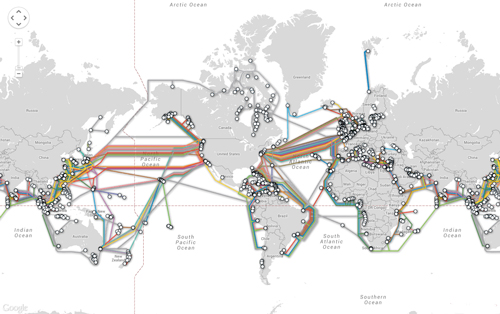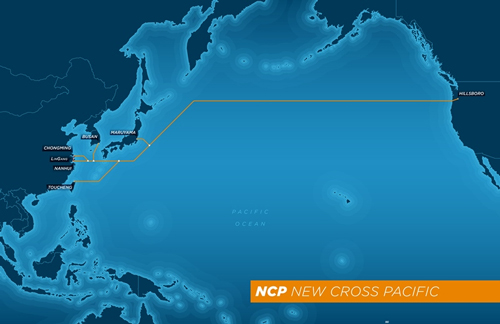With Partners, Microsoft Taking the Cloud Underwater
Taking its public cloud infrastructure buildout beneath the sea, Microsoft this week unveiled investments in three trans-oceanic cable projects to improve the connections among its international datacenters.
"As we expand our cloud services and global infrastructure, we need a strong subsea strategy to ensure our customers experience high availability access to their data," David Crowley, managing director of network enablement for Microsoft, blogged earlier this week. "Over the past nine months, Microsoft has been significantly investing in subsea and terrestrial dark fiber capacity by engaging in fiber partnerships that span multiple oceans and continents. And today, our connections across the Atlantic and Pacific just got stronger."
At first blush, satellite connections for intercontinental communication might seem more in line with the concept of cloud. Both clouds and low earth orbit are "up" from here on the ground. But in the real world of hardware, wiring and electricity where the "cloud" actually exists, it's undersea cables that do the work of moving data between continents. Some estimates put the amount of intercontinental data moving through subsea cables at 99 percent. When it comes to international data, the "cloud" in a lot of those marketing diagrams might be more accurately represented by a fish tank.
Microsoft's global cloud efforts have always depended on such cabling, but now Microsoft is investing in fiber partnerships that will guarantee it higher priority and the latest bandwidth capability by helping to add three cables to the 230-plus cables already criss-crossing the ocean floor. "These cables will help deliver data at higher speeds, with higher capacity and lower latency for our customers across the globe," Crowley said.
 [Click on image for larger view.] A map of planned and active submarine cable systems. (Source: TeleGeography/Submarine Cable Map.)
[Click on image for larger view.] A map of planned and active submarine cable systems. (Source: TeleGeography/Submarine Cable Map.)
Microsoft's specific moves involve two transatlantic cables and one transpacific cable:
- Hibernia Networks sent out three ships this week to start laying a transatlantic cable for its Hibernia Express project, which will connect Halifax, Canada, with Ballinspittle near Cork, Ireland, and pass on to Brean, which is near Bristol in the U.K. Hibernia Networks says the cable, which is supposed to begin service in September of this year, will be the first new transatlantic cable in 12 years. "Hibernia Networks is proud to have been selected by Microsoft to provide a key piece to their existing backbone network on our transatlantic cable system," said Hibernia's CEO Bjarni Thorvardarson in a statement.
- Aqua Comms Ltd. also announced that Microsoft would be its first "foundation customer" on the America Europe Connect (AEConnect) subsea cable system. That cable, being built by TE SubCom, which is involved in all three of the Microsoft-related projects, is supposed to go into service in December 2015 and stretch from Shirley, N.Y., to Killala, Ireland. Asked in an e-mail interview why Microsoft was supporting two new transatlantic cables, Crowley said, "We optimized for two cables to ensure physical diversity, availability and uptime for customers."
- Microsoft is one of a number of players in the new transpacific cable announced this week. TE SubCom began construction on the New Cross Pacific (NCP) Cable Network, which will run from Hillsboro, Ore., to the Chinese mainland in three places at Chongming, Nanhui and Lingang. It will also connect to Busan, South Korea; Toucheng, Taiwan; and Maruyama, Japan. Other members of the NCP consortium include Chunghwa Telecom Co. Ltd., China Mobile, China Telecom, China Unicom, KT Corp. and SoftBank Mobile Corp. The 13,000-kilometer network is planned for service launch in late 2017.
 [Click on image for larger view.] A map of Microsoft's planned subsea cables to connect its Hillsboro, Ore., landing station to areas in the Asia-Pacific region. (Source: Chunghwa Telecom.)
[Click on image for larger view.] A map of Microsoft's planned subsea cables to connect its Hillsboro, Ore., landing station to areas in the Asia-Pacific region. (Source: Chunghwa Telecom.)
Investing in undersea cable is not completely new for Microsoft. Last September, Microsoft and Seaborn Networks agreed to work together on a U.S.-Brazil subsea cable, which is called Seabras-1 and is planned to go live in 2016. The difference is in the scale of the announcements this week -- there were three at once and they covered a much broader geographical area. While Crowley declined to say how much Microsoft is investing or what percentage of the available bandwidth its participation is securing, such projects typically cost hundreds of millions of dollars.
Whatever the specific amount, it's a significant addition to the billions Microsoft has already poured into that global cloud buildout. Dollar by dollar, Microsoft continues to press its financial and scale advantages to ensure that it remains in a very small class of megavendors for public cloud services.
Posted by Scott Bekker on May 13, 2015